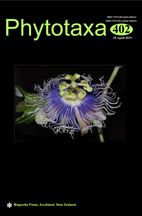Abstract
A new natural hybrid in the genus Laelia, from the Mixtec region in Oaxaca state, Mexico, is described and illustrated. Laelia × tlaxiacoensis is the name given to a hybrid between L. albida and L. furfuracea. Both Laelia species are sympatric in the region where the hybrid comes from and they coincide in their bloom season. The hybrid looks like a plant of L. albida bearing an inflorescence from L. furfuracea. Laelia × tlaxiacoensis differs from L. albida by its lilac flowers, less floriferous raceme, rhombic and erect petals, and the labellum narrower at the mid-lobe than across the lateral lobes spread out. From L. furfuracea, the hybrid differs by its longer inflorescence, proportionally narrower leaves, orbicular labellum, and straight column. Information about distribution, habitat, phenology, and conservation status for the new hybrid is provided. A potential distribution model was generated for the putative parents of L. × tlaxiacoensis, showing the region where both become sympatric and the occurrence of the new hybrid in it.

